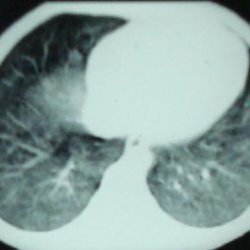Idiopathic hemosiderosis of the lungs
 Idiopathic hemosiderosis of the lung is a disease characterized by multiple repeated hemorrhages to the lungs and is especially scary in the subsequent development of hemosiderosis and lung sclerosis, as well as anemia.
Idiopathic hemosiderosis of the lung is a disease characterized by multiple repeated hemorrhages to the lungs and is especially scary in the subsequent development of hemosiderosis and lung sclerosis, as well as anemia.
For the first time this disease was described by our scientist R. Virchow in 1864.Idiopathic hemosiderosis of the lungs is extremely rare and mainly in children aged 3 to 8 years. Several cases were noted when whole families became ill with the disease.
Cause
The etiology is not well understood and, unfortunately, the cause has remained unknown. But there are assumptions that argue that the cause of this disease is the underdevelopment of the elastic framework of the pulmonary vessels, resulting in aneurysms, as well as blood stasis and diapatez hemorrhages in the lungs. Along with this version, there is a version of the fact that this disease is caused by some kind of infection or intoxication. This version arose from the fact that there are many cases of idiopathic hemosiderosis of the lungs that arose after such diseases as whooping cough, measles, acute respiratory infections and pneumonia. But the role of microbes is also not proven. The development of this disease is also attributed to allergies and auto-alergies, as well as a list of diseases such as Shenllein-Henoch disease, myocarditis, glomerulonephritis, crises with increasing immunoglobulins of blood and other equally serious diseases.
Symptoms of idiopathic hemosiderosis of the lungs
Idiopathic hemosiderosis of the lung can have both acute and chronic course of the disease with the emergence of many exacerbations. Acute mainly occurs in children. Complaints of patients in the acute course of the disease are sufficiently monotonous and characteristic. They complain of a cough with expectoration of blood sputum. As it turned out, hemoptysis is one of the most important symptoms that you need to pay attention to. Without expectoration of the blood, this disease basically does not pass. In addition to all the above, the patients are tormented by shortness of breath, dizziness, also they complain of noise in the ears and with sudden movements flashes of flies. These complaints are mainly due to the development of anemia, because there is a prolonged spitting of blood. The appearance of dyspnea in patients can contribute to the development of such a disease as diffuse pneumosclerosis, this if the disease has taken a progressive nature. Often, patients complain of pain in the chest, as well as in the joints, in the abdomen, often raising the body temperature, people at the same time begin to significantly lose weight.
Also hemosiderosis of the lungs can get its development due to the fact that there is a so-called stagnation in a small circle of blood circulation and there is a circulatory insufficiency. And with auscultation of the lungs, finely bubbling rales are determined and syderophages may be present in the sputum. Such stagnant hemosiderosis can be detected very simply - with the help of a clinical picture of heart disease, which led to stagnation in the lungs. But this is what concerns stagnant hemosiderosis of the lungs.
Very often cases when patients are mistaken in their condition, thanks to the appearance of remission. With her, all the symptoms are muffled and the patients begin to forget about the treatment, however the duration of remission varies.
When examining such patients, it is necessary to pay due attention to the pallor of the patients, the mucous membranes and cyanosis. Pallor mainly depends on the degree of cyanosis or anemia, or rather on the degree of insufficiency of breathing. With the appearance of extensive hemorrhages in the tissues of the lungs, dullness of percussive sound occurs and, above this zone, bronchial breathing can be heard. Often such patients are diagnosed with bilateral pneumonia. With a full study of the lungs, you can listen to a very important sign of idiopathic hemosiderosis of the lungs, namely wet small bubbling rales and less often dry rales.
A very disappointing factor is that idiopathic hemosiderosis of the lungs can go into infarct-pneumonia, which in turn can be extensive and can cause severe respiratory failure, and this disease can be complicated by severe bleeding. And it is these complications that can lead to death.
What tests should I take to study and identify idiopathic hemosiderosis of the lungs?
You will need to pass:
- blood and urine tests are common;
- biochemical blood test to detect total protein and protein fractions in general, check bilirubin, seromucoid, fibrin, haptoglobin, and iron level;
- content of B- and T-lymphocytes, immunoglobulins and check circulating immune complexes;
- to do an x-ray lung examination;
- do an ECG;
- to do spirography is a function of external respiration;
- to make ultrasound of the heart, liver, spleen and kidney;
- check for a lung biopsy.
Treatment of this disease is as follows: doctors prescribe special drugs that begin to suppress autoimmune reactions and reduce vascular permeability. Often doctors can prescribe prednilazone from 30 to 50 milligrams. If there is an improvement, the dose of this drug is reduced within three months to the dose that will be supportive, which is about five milligrams.
It should be noted and the existing method of combined treatment with plasmapheresis. With the help of this plasmapheresis, the so-called accumulated antibodies are removed from the blood plasma, and the cytostatics used reduce the number of new unnecessary antibodies. Of the drugs, mainly prescribed azathioprine and shklofosfan four hundred milligrams per day, and the whole course of treatment - the use of ten grams of this drug.
Along with these strong drugs, use also iron preparations with anticoagulants and with other means called heparin, quarantil and use more trental.
In addition, do not forget that due to the development of iron deficiency anemia, patients should not forget about the use of drugs that contain iron.
I would very much like that this terrible disease does not catch up with anyone, since it has not been completely investigated and the reasons for its occurrence also remain unknown. But, undoubtedly, it pleases that our doctors are looking for reasons and ways to combat such a disease with a terrible name.



